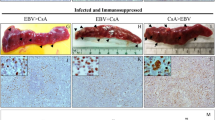Abstract
DEFECTIVE type C RNA tumour viruses which are genetic recombinants between ecotropic and xenotropic viruses have been described and suggested to be the real transforming agents during the course of viral-induced lymphatic leukaemia1,2. The spleen focus-forming virus (SFFV-F) component of the Friend virus (FV) complex is a defective virus and is the erythroid-specific component of the complex which stimulates erythropoiesis in the mouse and is also involved in the relatively rare event of erythroid transformation3,4. In order to examine the role of the SFFV component during erythroblastosis and subsequent transformation of erythroid cells, we have synthesised a SFFV-specific probe using FV released from F4-6, a transformed erythroid cell line5,6. We report here that, using this probe, no xenotropic sequences are present in the SFFV-specific cDNA and that there is a low level of transcription of part of the SFFV sequences but not specifically during normal erythroid differentiation. Our results thus show that if SFFV is a recombinant virus, the xenotropic sequences are only present in the lymphatic leukaemia virus (LLV)-related common sequences of the FV genome. Furthermore, our experiments do not support a hypothesis whereby the specific action of SFFV can be explained by transcription of the SFFV-specific genome during normal erythroid differentiation.
This is a preview of subscription content, access via your institution
Access options
Subscribe to this journal
Receive 51 print issues and online access
$199.00 per year
only $3.90 per issue
Buy this article
- Purchase on Springer Link
- Instant access to full article PDF
Prices may be subject to local taxes which are calculated during checkout
Similar content being viewed by others
References
Staal, S. P., Hartley, J. & Rowe, W. P. Proc. natn. Acad. Sci. U.S.A. 74, 3065–3067 (1977).
Waksal, S. & Decleve, A. in Oncogenic Viruses and Host Cells Genes (ed. Ikawa, Y.) (Academic New York, in the press).
Steeves, R. A. J. natn. Cancer Inst. 54, 289–297 (1975).
Jasmin, C., Le Bousse-Kerdiles, F., Smadja-Joffe, F., Klein, B. & Caillou, N. in Oncogenic Viruses and Host Cell Genes (ed. Ikawa, Y.) (Academic, New York, in the press).
Pragnell, I. B., Ostertag, W. & Paul, J. expl Cell Res. 108, 269–278 (1977).
Ostertag, W. et al. in Differentiation and Control of Malignancy of Tumour Cells, (eds Nakakara et al.) 485–531 (Univ. Tokyo Press, 1973).
Troxler, D. H., Parks, W. P., Vass, W. C. & Scolnick, E. M. J. Virol. 76, 602–615 (1977).
Troxler, D. H., Boyers, J. K., Parks, W. & Scolnick, E. M. J. Virol. 22, 361–372 (1977).
Ostertag, W. & Pragnell, I. B. Proc. natn. Acad. Sci. U.S.A. (in the press).
Fieldsteel, A. H., Kurahara, C. & Dawson, P. J. Nature 223, 1274 (1969).
Troxler, D. H., Lowy, D., Howk, R. S., Young, H. & Scolnick, E. M. Proc. natn. Acad. Sci. USA. 74, 4671–4675 (1977).
Elder, J. H. et al. Proc. natn. Acad. Sci. U.S.A. 74, 4676–4680 (1977).
Hartley, J. W. & Rowe, W. P. Virology 65, 128–134 (1975).
Dube, S. K. et al. Proc. nain. Acad. Sci. U.S.A. 72, 1863–1867 (1975).
Ikawa, Y. & Yoshida, M. in Oncogenic Viruses and Host Cell Genes, (ed. Ikawa, Y.) (Academic, New York, in the press).
Fan, H. & Baltimore, D. J. molec. Biol. 80, 93–117 (1973).
Taylor, J. M., Illmensee, R. & Summers, J. Biochim. biophys. Acta 442, 324–330 (1976).
Young, B. D. et al. J. molec. Biol. 84, 555–568 (1974).
Harrison, P. R. et al. J. molec. Biol. 84, 539–554 (1974).
Scolnick, E. M. et al. Proc. natn. Acad. Sci. U.S.A. 72, 4650–4654 (1975).
Maisel, J., Klement, U., Lai, M. M.-C., Ostertag, W. & Duesberg, P. Proc. natn. Acad. Sci. U S.A. 70, 3536–3540 (1973).
Rolton, H. A., Birnie, G. D. & Paul, J. Cell Different. 6, 25–39 (1977).
Glisin, V., Crkvenjakov, R. & Byus, C. Biochemistry 13, 2633–2637 (1974).
Author information
Authors and Affiliations
Rights and permissions
About this article
Cite this article
PRAGNELL, I., MCNAB, A., HARRISON, P. et al. Are spleen focus-forming virus sequences related to xenotropic viruses and expressed specifically in normal erythroid cells?. Nature 272, 456–458 (1978). https://doi.org/10.1038/272456a0
Received:
Accepted:
Published:
Issue Date:
DOI: https://doi.org/10.1038/272456a0
Comments
By submitting a comment you agree to abide by our Terms and Community Guidelines. If you find something abusive or that does not comply with our terms or guidelines please flag it as inappropriate.



